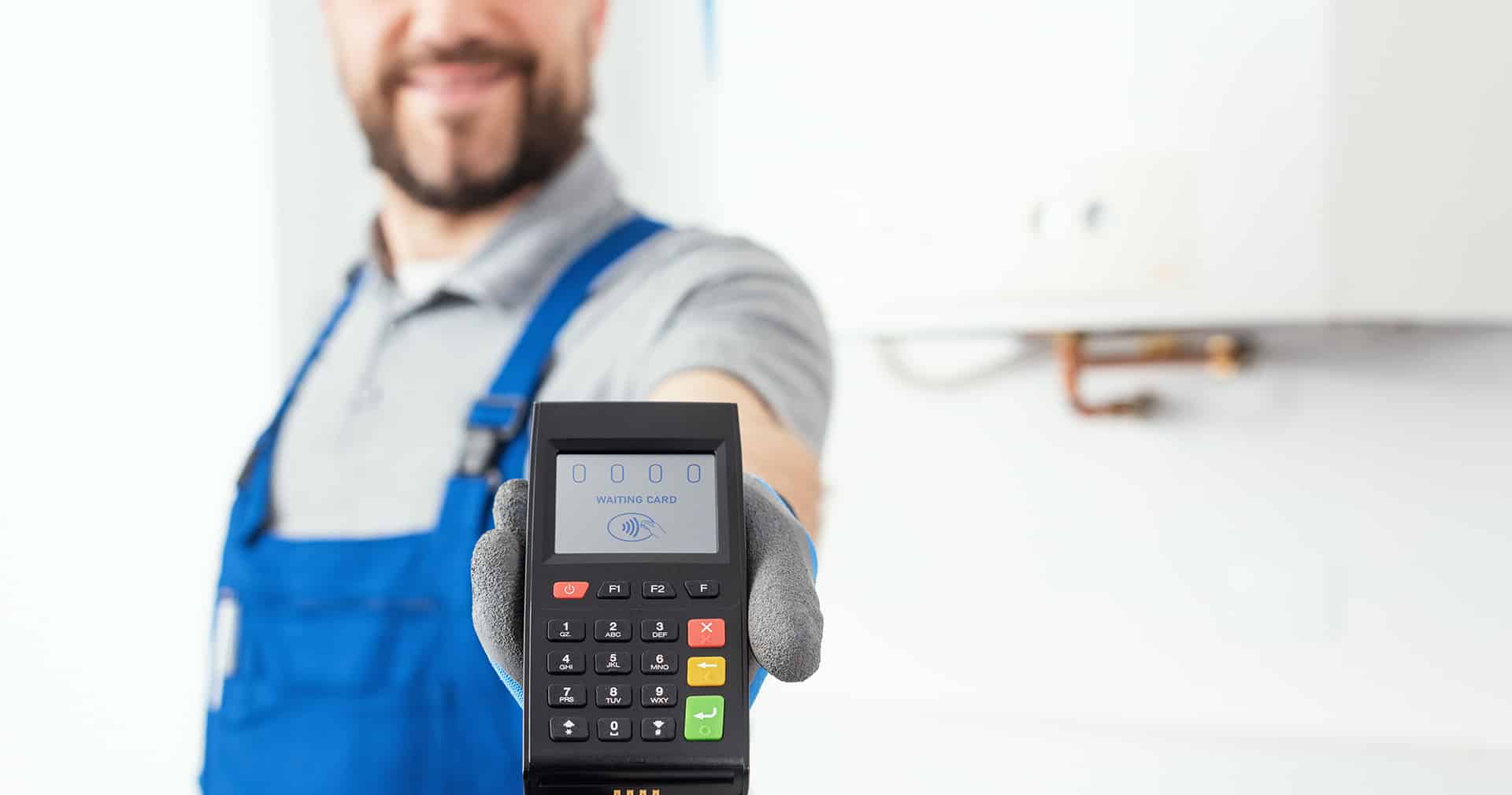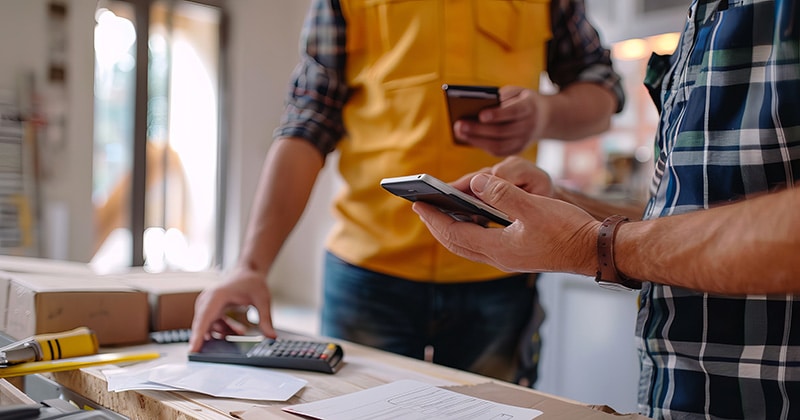
In an ideal world, you’d get paid on time every time.
And while you might not achieve perfection, you can still encourage fast payments. How? By catering to your clients’ preferences.
Every year, fewer and fewer Americans use cash. In contrast, more of us use credit and debit cards and digital payment methods.
As expectations shift, so, too, should your payment methods. That’s why now could be the time to embrace the future and become a cashless business.
In this article, we’ll explore the evolution of payment methods in the home services industry. We’ll share the benefits of being a cashless business and how it can boost the customer experience.
We’ll look at the top data security and compliance concerns. And we’ll finish with a few quick tips on how to go cashless so you can take action now.
RELATED ARTICLE: How Field Service Companies Can Improve Cashflow with Digital Payments
The Evolution of Payment Methods in Home Services

If you’ve been in business for some time now, you might’ve noticed customer payment preferences change.
Until now, home service providers have relied on traditional payment methods. However, check and cash payments now present challenges.
While checks were once popular, today, they make up just 4% of transactions. And just under half of Americans haven’t written a check in the past 12 months.
Likewise, cash has been a popular payment method in the industry. It makes sense. Cash is about as straightforward as it gets. You do the job. You get paid immediately. No waiting for checks to clear.
While cash might seem like the easiest payment option, but it comes with its own set of challenges.
Top Challenges of Cash Transactions
What’s the problem with cash? For one, handling cash isn’t exactly easy.
You might have to haul around change to give back to customers. You need to count and sort the money, which can slow down your workday.
Not to mention the challenge of tracking cash as compared to digital payments. The risk of misplacing or losing funds is higher unless you have a highly developed accounting and tracking system.
Another challenge is the time spent going to the bank. You have to deposit your cash, which means driving to the bank, waiting in line, and filling out deposit slips. You’ve got better things to do, like growing your business or serving more customers.
And then there’s the risk of carrying large sums of money. It’s an uncomfortable feeling knowing you have a few hundred—even a few thousand—dollars in your pocket.
You could be robbed. Or you could misplace the money. Once it’s gone, it’s gone for good.
Finally, not everyone has cash on hand or prefers to use it. It’s inconvenient to run to an ATM before paying.
Some might even decide not to use your services if you don’t offer a more modern payment option. This can lead to missed opportunities and lost revenue.
The Future of Payments is Digital
Cash used to be king, but that’s no longer the reality. Cashless payments are skyrocketing in popularity as more payment methods enter the market.
Cashless methods include credit cards, digital wallets, mobile payment apps, and online banking. They are quick and contactless. And there’s no need to carry physical money around.
You can set the standard by adopting cashless payment options. Make the move and reap the rewards we’ll explore below.
FROM ONE OF OUR PARTNERS: The Most Popular Mobile Payment Methods for Business Owners
Benefits of a Cashless Home Services Business

The job’s done. You pull out a card reader, and bam! The payment is made.
You can also send an invoice with a payment link. The customer clicks, enters their details, and that’s it. The money is transferred securely.
Moving to a cashless business can make these scenarios a part of your daily life. You can take advantage of:
- Payment efficiency. Cashless payments save you time. No more counting bills or dealing with loose change. You can spend more time on the quality of your services. This leads to happier customers, more referrals, more business, and more revenue.
- Unmatched convenience. You may have probably opened an email and thought, “Too hard. I’ll deal with that later.” Your clients think the same. They want easy and cashless payments delivered. Your customers can pay fast, which means less time spent chasing overdue invoices. Plus, easy payments are good for the customer experience.
- Greater security. Cashless transactions eliminate the risks associated with carrying and storing cash. Don’t worry about theft or losing money between the job site and the bank. Digital payments are tracked and secured by payment processors.
Streamline Operations with Cashless Payments
Put the benefits above together, and what do you get? Operations that run without a hitch.
For example, say you use an app that integrates with your booking system. Payments are linked to each job without manual effort.
You finish a plumbing repair job. You send the customer an invoice through the app right away. They pay on the spot using their phone.
The payment is recorded instantly, and the money goes directly into your account. It’s all done in minutes.
Leverage Payment Data to Improve Your Business
Another huge drawcard of cashless payments is all the data you get.
For example, you can use digital payment records to see which services earn you the most money. You can track which days are busiest or how quickly customers pay on average.
Then, you can use this data to make informed, growth-driving decisions. If you notice that a particular service brings in more revenue, you might decide to promote it, for example.
FROM ONE OF OUR PARTNERS: 12 Ways to Leverage Payments and Increase Revenue
Enhancing the Customer Experience

Customers are the heart of your business. They are key to your survival.
When you prioritize what they need and want, your business is unstoppable. This work ethos spans every element of your operations—from marketing and pricing to payments.
Meet Your Customers Where They’re at With Diverse Payment Options
Some people like credit cards. Others want to use digital wallets.
Some of your clients are older, so they’re more comfortable with traditional payment methods. Some of your contracts are high value. These clients want a low-risk way to pay.
The variables are limitless. But you can—and should—cater to them all.
Let’s look at some examples.
Someone paying for a quick lawn service might use a mobile app like Apple Pay.
Another customer hired you for a full-scale landscaping job. They want to transfer funds electronically from their bank to yours.
Enabling both of these customers to pay their way shows you’re flexible and committed to the customer experience.
It sets you apart. You demonstrate through actions that you’re customer-centric.
Build Trust and Loyalty with Modern Payment Methods
Modern payments build trust. You offer secure, reliable, and convenient payment options.
Digital payments are often encrypted and protected. This cuts the risk of fraud. Customers feel safe knowing their information is handled with care.
In addition, when you make it easy for customers to pay, they’re more likely to return. Every interaction they have with your business is positive. They’ll share this experience with friends and family.
Over time, this builds loyalty and can lead to more word-of-mouth referrals. Happy customers who trust your business are your best—and cheapest—marketing tool.
FROM ONE OF OUR PARTNERS: Why Your Small Business Should Accept Mobile Payments
Addressing Data Security Concerns and Compliance
Cash might come with its own risks. However, once you take payments online, you potentially open your business to various cyber threats and considerations.
One is data security. This is all about protecting sensitive information. You don’t want your or your client’s payment info to fall into the wrong hands.
Another big concern is fraud. Fraud occurs when someone uses a customer’s payment information to make unauthorized transactions. Your customers lose money, and you could be held liable.
These risks sound scary, but don’t panic, and don’t be put off. Instead, educate yourself and move forward confidently.
Best Practices for Securing Payment Information
First, familiarize yourself with security best practices. Following these can close gaps and prevent vulnerabilities:
- Always use encrypted payments. This means data is transformed into a code that only authorized people can break. Even if a data breach occurs, the malicious actor can’t make sense of the information.
- Comply with the Payment Card Industry Data Security Standard (PCI DSS). These are a series of security standards for companies that handle credit card information. By complying, you protect cardholder data and mitigate security risks.
- Keep software up to date. Threats evolve. They have become increasingly sophisticated. Software updates often include security patches that protect against the latest threats. Why not set up automatic updates? That way, you’ll never be caught out.
- Invest in training for your employees. Human error is a significant contributor to security breaches. Make sure your team knows how to handle information securely. Educate them on prevalent scams like phishing attempts.
Secure Your Cashless Transactions
Following the best practices is a start. Tighten your stronghold by adding these steps, too:
- Use two-factor authentication (2FA). This means you’ll need to provide two forms of identification before accessing an account. For example, the site might send a one-time code to your phone after entering your password. 2FA makes it much harder for unauthorized users to access your data.
- Audit your systems regularly. Check for vulnerabilities and software updates. That way, you can implement safeguards before gaps are exploited.
- Only partner with trusted and compliant payment processors. They should have robust security measures in place. Features like fraud detection and 24/7 monitoring are also a plus.
3 Tips to Transition to a Cashless Home Services Business
Ready to go cashless? Here are three tips you can start using today:
- Consider your business needs. What type of customer do you serve? What is the average value of your contracts? These questions will help you determine which payment methods fit your needs.
- Research payment processors. Jump online and search for reliable payment processors. You want low fees without compromising on ease of use and security. As a bonus, look for a processor that integrates with your existing systems.
- Think about your communication strategy. When you make a change to your business, you’ll need to tell your customer about it. Plan how you’ll do this.
Related Posts
The Essential Painting Equipment List for Your Business
Continue ReadingGet Inspired: Our Favorite Actual Pool Company Names
Continue ReadingStay Informed
Get the latest news and insights plus, Service Fusion offers and updates.Thank you for your submission.

SHARE